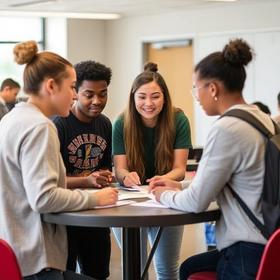As society evolves, our institutions must accommodate change or risk becoming obsolete. Community colleges, as providers of higher education in a particular geographic area, must be responsive not only to local community needs but also to national developments and demographic changes. This report examines seven prominent trends in community colleges today.
1. Increased Distance Learning
Using the internet as the primary tool, community colleges have embraced distance learning. Responding to the demand for more distance education, some community colleges offer particular courses online and some offer online degree programs that are completely online. The ability to take college courses online makes access to higher education possible for more students. The hallmark of online education is the flexibility it affords to students needing to coordinate their studies with business or personal obligations. For example, a student with a full-time job can access an online course before or after work or on days off. Stay-at-home parents can participate in online classes before the children get up, while they are at school, and after they go to bed at night. Students who live in geographically remote areas can attend college without having to relocate or travel great distances. The popularity of distance learning guarantees that the trend toward more online course offerings will continue.
This video looks at 7 Common Misconceptions About Distance Learning.
2. Greater Number of Baccalaureate Degrees Awarded
Historically, four-year colleges and universities awarded bachelor's degrees and advanced degrees (and not associate's degrees) and community colleges awarded associate's degrees (and not bachelor's degrees). Now, however, an increasing number of community colleges also offer baccalaureate degrees. The practice began as a response to the acute teacher shortage. States allowed community colleges to award baccalaureate degrees to prospective teachers in areas of particular need, such as math and science. Community college baccalaureate programs have also been established in areas that are not adequately served by four-year institutions because they are too costly or geographically too far away. Proponents of community college baccalaureate degrees claim that the practice serves the wider goal of making a college education more accessible. The subject is controversial, however. Some fear that the community college teaching programs may not be as rigorous as those of four-year institutions or worry about competition with the four-year programs.
3. Increased Partnerships between Community Colleges and Four-Year Institutions
Partnerships between community colleges and four-year institutions originated in California but are becoming prevalent throughout the country. When a community college partner with a four-year institution, the community college serves as a "feeder" of qualified students to the four-year institution. The arrangement smoothes the transition from the community college to the four-year institution by ensuring that credits will transfer and by giving preferential treatment to the community college students.
For example, if a student initially wanted to attend a four-year university but did not meet its academic standards, enrolling at a community college that partners with the desired university may allow the student to transfer to the desired institution for the final two years. The student may prefer the community college option over settling for a less desired four-year school or delaying a year to reapply at the desired four-year school.
4. Greater Recruiting of Baby Boomers
The American Association of Community Colleges recently received a $3.2 million grant to conduct a program designed to attract students 50 years old and over. Called the Plus 50 Initiative, the program will identify a pilot group of 15 community colleges that will receive sub-grants to expand or create programs of particular interest to persons in the over-50 age category. The focus will be on learning, training, and service. Many baby boomers intend to work past the traditional retirement age. Some of them want to change careers or engage in public service. If the Plus 50 Initiative proves successful, we can expect to see similar programs adopted by community colleges nationwide.
5. Increased Enrollment Across Different Student Groups
Community college students are a diverse group in which traditional students coming directly from high school seeking a degree are outnumbered by non-traditional students. The following types of students illustrate some of the trends in community college enrollment.
Concurrently enrolled high school students – There is a growing demand for concurrent enrollment programs, which allow high school students to take college-level courses. Dual-credit students are enrolled in college courses for which they earn both college credit and credit toward their high school graduation. Dual-enrollment students take college courses for college credit in addition to their regular high school courses. The programs vary considerably among the colleges. They have been characterized as "high-value programs" because they supply many elements that high school does not provide for most students, including "challenge, engagement, access to the adult world, and support." While the long-term benefits for concurrent students are not as clear, they may include better preparation for college and higher academic performance.
Reverse transfer students – In the traditional sequence of events, students transfer to a four-year institution after completing two years at a community college. Reverse transfer students transfer from a four-year institution to a community college. There are a number of reasons why a student would make a reverse transfer. For example, a student who has been unsuccessful at a four-year school may enroll at a community college to build up enough credits to re-enroll at the four-year school. Some students who have completed their bachelor's degrees enroll at community colleges to acquire or improve their job skills.
Iraq and Afghanistan war veterans – Increasing numbers of veterans of the Iraq and Afghanistan wars are enrolling at community colleges. Many of these young veterans have the same educational goals as other students, e.g., to study toward a degree or to obtain job training. It may be premature to call it a trend, but community colleges may be challenged to make higher education accessible to severely wounded veterans, such as those who are paralyzed or missing limbs. These individuals need intensive medical attention, physical therapy, and living assistance that prevent them from matriculating as regular students. Community colleges may be able to supply the educational component of new comprehensive programs designed to help wounded veterans acquire the education and skills they need to return to the workforce.
6. Increased Partnership with Business
Closer cooperation between community colleges and the business community is an emerging trend. The present job market demands highly skilled technicians, programmers, and non-technical support personnel for the information technology industry. The fact that a job applicant has an associate's degree does not necessarily convey to an employer the nature or extent of an individual's skills. For that reason, many employers are interested not in degrees but rather in certifications that an individual has mastered the skills required for a job based on a recognized standard.
In a report entitled "More Than a Matter of Degree – Credentialing, Certification and Community Colleges," the National Council for Continuing Education and Training recommends that community colleges restructure their technical curricula to offer non-degree, non-credit programs focusing on competency and assessment. The goal is that, when a prospective employee has a certificate of completing a particular program, an employer can rely on the applicant having a particular skill or skill set taught in the program.
Community colleges face competition in the area of job training. If community colleges do not implement effective credentialing programs, the need will be filled by private sector trade schools, many of which are already in existence.
7. Increased Response to Globalization
Like government and business, education has responded to the reality of globalization. Community colleges are preparing students to succeed in an environment in which government policies and information technology have expanded employment opportunities beyond our national borders. For example, the Global Corporate College is a partnership between community colleges and industry formed to prepare students for jobs in a global economy. The goal is to establish a national or international "system of delivery for training services" for corporations with geographically dispersed workforces. The community colleges share curricula that offer high-quality, standardized training needed by a broad range of businesses. Courses offerings include general subjects, such as management, management systems, and information technology, as well as industry-specific training in manufacturing, technology, and health care. Training seminars and workshops can be customized for particular companies. Twenty community colleges already participate in the Global Corporate College; an additional 25 colleges are expected to join in 2008. The organization's headquarters are in Cleveland and its first international office will be in Beijing.
Conclusion
Community colleges are striving to meet new demands while continuing to fulfill their goal of making a college education accessible to all. The trends discussed in this report show that community colleges are attentive to numerous constituencies. They are reaching down to high school students, granting or assisting college students to obtain bachelor's degrees, and preparing unique curricula to attract students age 50 and over. They are also beginning to partner with the business sector to provide high-quality technical training that students need to succeed in business and industry. This is an ambitious agenda. Both the government and the private sector will be challenged to provide sufficient funding to allow community colleges to accomplish their changing missions.
Questions? Contact us on Facebook. @communitycollegereview















